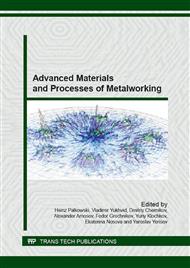p.165
p.177
p.185
p.193
p.198
p.204
p.211
p.218
p.222
The Wear-Resistance and Antifrictional Properties of Hard Alloys of Chromium Carbide with Titanium Produced by the Explosive Compaction of Powders
Abstract:
The tribological characteristics of the Cr3С2–Ti system hard alloys produced by the explosive compaction of powders containing 20, 30, 40, and 50 vol. % of the titanium binder are investigated. The general approach to selecting the optimal structure and properties of wear-resistant hard alloys for manufacturing the slider bearing parts working in conjunction with silicified graphite under water lubrication conditions is formulated. It is shown that, to attain the highest antifriction characteristics and minimal wear of the friction unit, the alloy should have the maximally possible hardness with the minimally admissible specific volume of a carbide phase in the material structure. It is established that such alloys have higher antifriction characteristics and wear resistance than silicified graphite and the Cr3C2–20% Ni-type materials produced by conventional methods.
Info:
Periodical:
Pages:
198-203
Citation:
Online since:
February 2016
Price:
Сopyright:
© 2016 Trans Tech Publications Ltd. All Rights Reserved
Share:
Citation:


